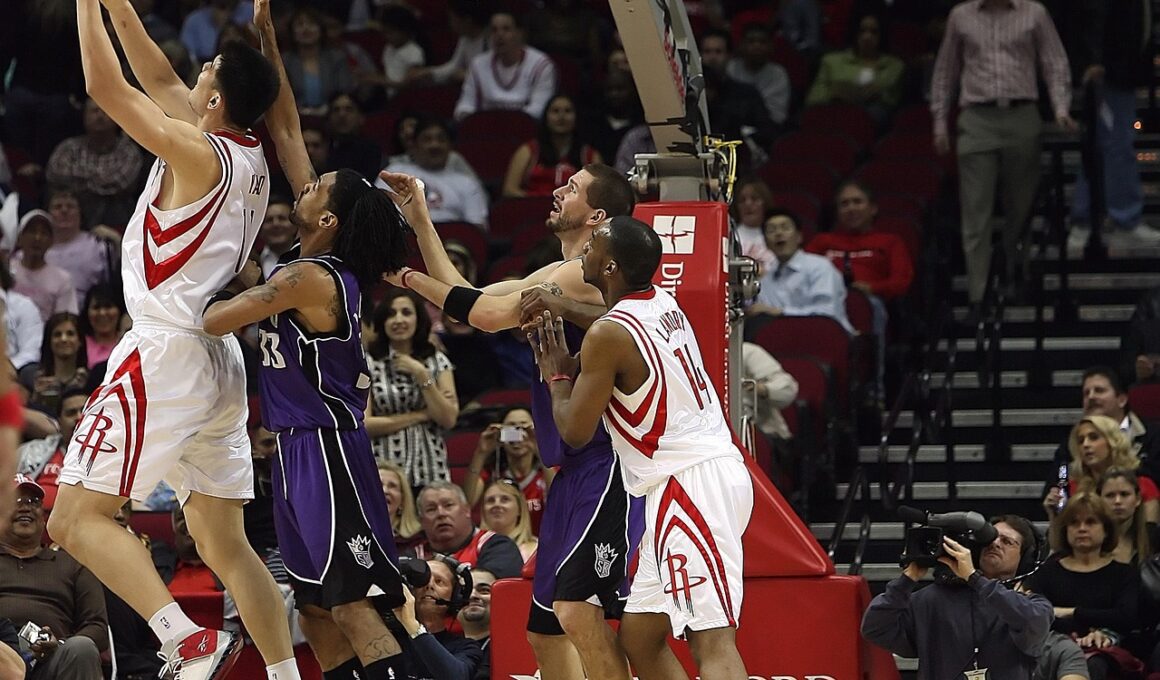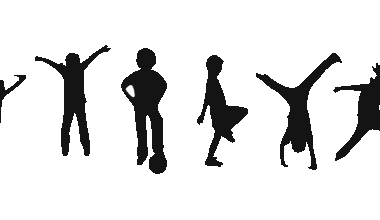Body Positioning During Passing: Drills to Improve Technique
Understanding body positioning is crucial in basketball, particularly during passing. The right stance can significantly enhance the effectiveness and accuracy of a pass. When a player prepares to pass, they should prioritize balance and stability. A wide base allows for better control over the ball and energy transfer. Players need to position themselves with feet shoulder-width apart, knees slightly bent, enabling quick movements to either side. Furthermore, body orientation matters—players must face their target to maintain a direct line for passing. Using the hips to pivot and turn facilitates better alignment with the intended target. Effective passing drills can emphasize these physical aspects, leading to improved overall performance on the court. Consistent practice of these drills will not only help in mastering technique but also in developing muscle memory. This skill will become second nature during an actual game, where split-second decisions must be made. Emphasizing correct body position will lead to successful passing opportunities, thus enabling a player to contribute effectively to their team’s strategy and execution. Practicing varying types of passes while maintaining proper body position is vital for every player aiming to improve their passing game.
One effective drill emphasizes passing against a wall, where numerous techniques can be honed. Players should stand about five feet away from the wall and practice chest and bounce passes. The aim is to focus on the foot positioning while passing to ensure the body faces the target. As the ball returns from the wall, players will work on catching the ball and maintaining their position. The drill can be intensified by increasing the distance from the wall or changing passing angles, encouraging players to adapt their footwork accordingly. Additionally, placing markers on the ground will assist in maintaining proper distances. Each time the ball is received, players must appreciate the significance of their body’s alignment, pivoting accordingly with each pass. This attention to detail both reinforces basic skills and develops strategic thinking skills. Therefore, this wall drill encourages players to concentrate on various aspects like rhythm, timing, and distance control. Overall, this routine ensures players develop agility and awareness on the court—a critical aspect during fast-paced play. Incorporating regular practice of this passing drill into a training regimen can yield impressive improvements.
Partner Passing Drills
Incorporating partner passing drills enhances body positioning and promotes teamwork. This drill involves pairing up players who practice passing to each other from varying distances. Emphasizing proper stance is essential when executing these passes. Players can begin close together and gradually increase the distance. Focusing on footwork and maintaining a good base will help achieve accurate passes. Communication is key; players should call for the ball, ensuring they are positioned correctly and ready to receive. Emphasizing eye contact encourages cooperation between teammates, leading to improved game strategies. Varying the types of passes during this drill—such as overhead, bounce, and chest passes—forces players to adapt their positioning and technique. Practicing in different positions challenges players to think creatively about passing angles during gameplay. Additionally, this drill encourages quick decision-making and fosters team chemistry, both essential in a basketball environment. Partner drills can help reinforce spatial awareness, which can be invaluable in creating effective plays. Regular practice with partners should be encouraged to establish rapport and mutual understanding—elements that can significantly impact team performance.
Another valuable drill for passing incorporates movement and positioning scenarios. Players can form a perimeter around the court or a designated space, passing to each other while moving. This dynamic drill emphasizes the importance of maintaining a solid stance while on the move and communicating with teammates. During this exercise, coaches should stress the significance of proper foot positioning, as players must be prepared to pivot and adjust rapidly. Motion passing drills enhance the fluidity of the game, allowing players to adapt their body positioning while receiving and delivering passes. Incorporating changes in direction, speed, and distance challenges players to continually adjust their stance, ensuring they are well-prepared for various in-game situations. This drill is essential for developing a player’s passing technique in a real-game context, ensuring adaptability. Regularly practicing these dynamic drills develops essential skills to maintain footwork while adhering to correct body alignment. Incorporating realistic scenarios during training prepares players to face greater challenges during actual gameplay, allowing them to shine under pressure, and ultimately aids in developing strategic reflexes that could be pivotal for team victories.
Introducing Variability in Drills
Variability during training sessions aids in reinforcing proper body positioning and passing technique. Coaches can introduce obstacles or defenders during passing drills, adding complexity to practice sessions. This approach strengthens players’ abilities to assess situations quickly and make accurate passes even under pressure. Players should focus on their foot positioning and balance, as their movements can impact the accuracy of passes. Adding defenders who challenge the receiver will require well-executed cuts and quick footwork, creating more realistic scenarios. This type of training change fosters not only skill enhancement but also resilience in the face of competitive challenges. Teams benefit significantly from practicing these drills, as they enhance strategic thought processes while executing plays. Furthermore, employing situational drills can showcase various game scenarios, preparing players for unexpected developments. Coaches can simulate turnovers or fast-break situations, requiring effective passing to maintain momentum. This adaptability is crucial to a team’s success. By incorporating variability in passing drills, players build confidence and readiness to execute favorable passes during real games, further solidifying their understanding of body positioning and technique.
Feedback is an integral part of mastering passing techniques. Providing constructive feedback during drills allows players to refine their techniques progressively. Coaches can observe each player’s stance and foot positioning while they practice and give tailored advice. Highlighting the importance of awareness of body movement can lead to improved performance when executing a pass. Encouraging peer feedback among players can also provide mutual learning opportunities. Constructive criticism fosters an environment where teamwork is emphasized, and players feel accountable for their performance. Recording drills for review can further enhance feedback loops, allowing players to see their positioning and execution independently. Analyzing different aspects such as foot alignment and shoulder positioning will demonstrate improvement areas. During this analysis, players can develop a keener understanding of ideal body positioning for successful passes to teammates. Emphasizing self-evaluation and awareness throughout training is vital for personal growth within the sport. Continuous evaluation and adjustment ultimately lead to mastery over body positioning, fundamental for enhancing overall passing technique. Implementing these feedback mechanisms during practice can lead to significant advancements over time in player skill levels.
Conclusion and Continuous Improvement
In conclusion, mastering body positioning during passing drills directly impacts overall basketball performance. Through dedicated practice focusing on various drills—such as wall drills, partner passing, and perimeter routines—players build the necessary skills for effective passes. Engaging in these practices reinforces the physical aspects critical to executing successful passes, from foot stance to shoulder orientation. By incorporating feedback and variability, coaches and players can continuously improve techniques and strategies during drills. Developing awareness of positioning in real-game scenarios will further enhance a player’s effectiveness on the court. Always striving for correct body alignment will yield positive results over time, turning players into reliable teammates. Players should remain committed to practice and give their best effort to mitigate passing errors in real-game situations. Awareness of body positioning can make a substantial difference in gameplay outcomes, allowing teams to flourish. Ultimately, practicing these skills consistently ensures readiness for competitive environments, equipping players with the confidence necessary for success. Teams benefiting from these techniques will deepen their understanding of passing dynamics, elevating their game as essential components of team strategy and play development.
As basketball training evolves, the importance of focusing on body positioning cannot be overstated. Utilizing these drills will foster a passion for passing excellence among players while enhancing overall mechanical reflexes. The foundation for successful passing starts with understanding body alignment principles, requiring commitment and dedication to regular practice. Coaches and players must work harmoniously to utilize these techniques effectively, ensuring players recognize situations where proper positioning plays a pivotal role. These fundamental elements will serve as building blocks for aspiring players looking to improve their passing skills. The journey toward mastery is ongoing; as they continue to implement these drills, players will notice improvements both personally and collectively. A cohesive understanding within the team promotes a positive environment conducive to mutual growth and success, continuing to improve basketball skills through simple yet effective passing drills. Passionate players seeking enhancement should embrace these drills as opportunities for self-expression while contributing to team goals. With patience, diligence, and commitment, mastering body positioning for effective passing can become second nature for every basketball player striving for excellence.


